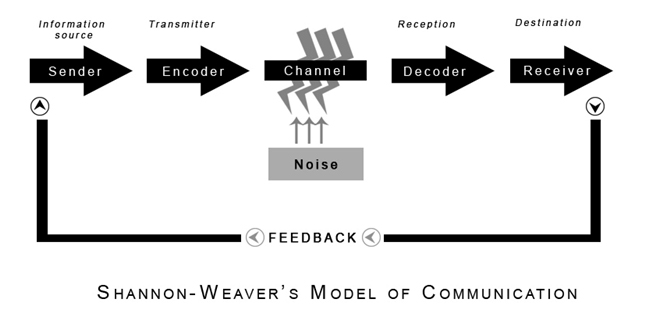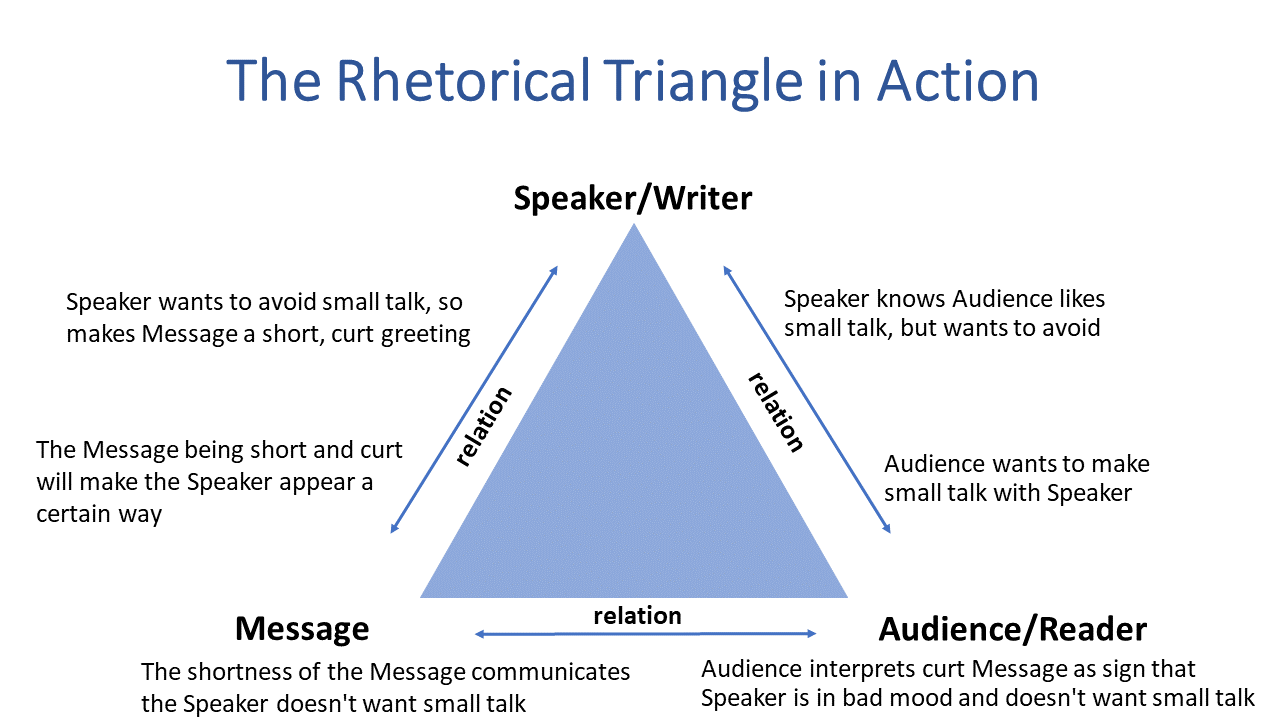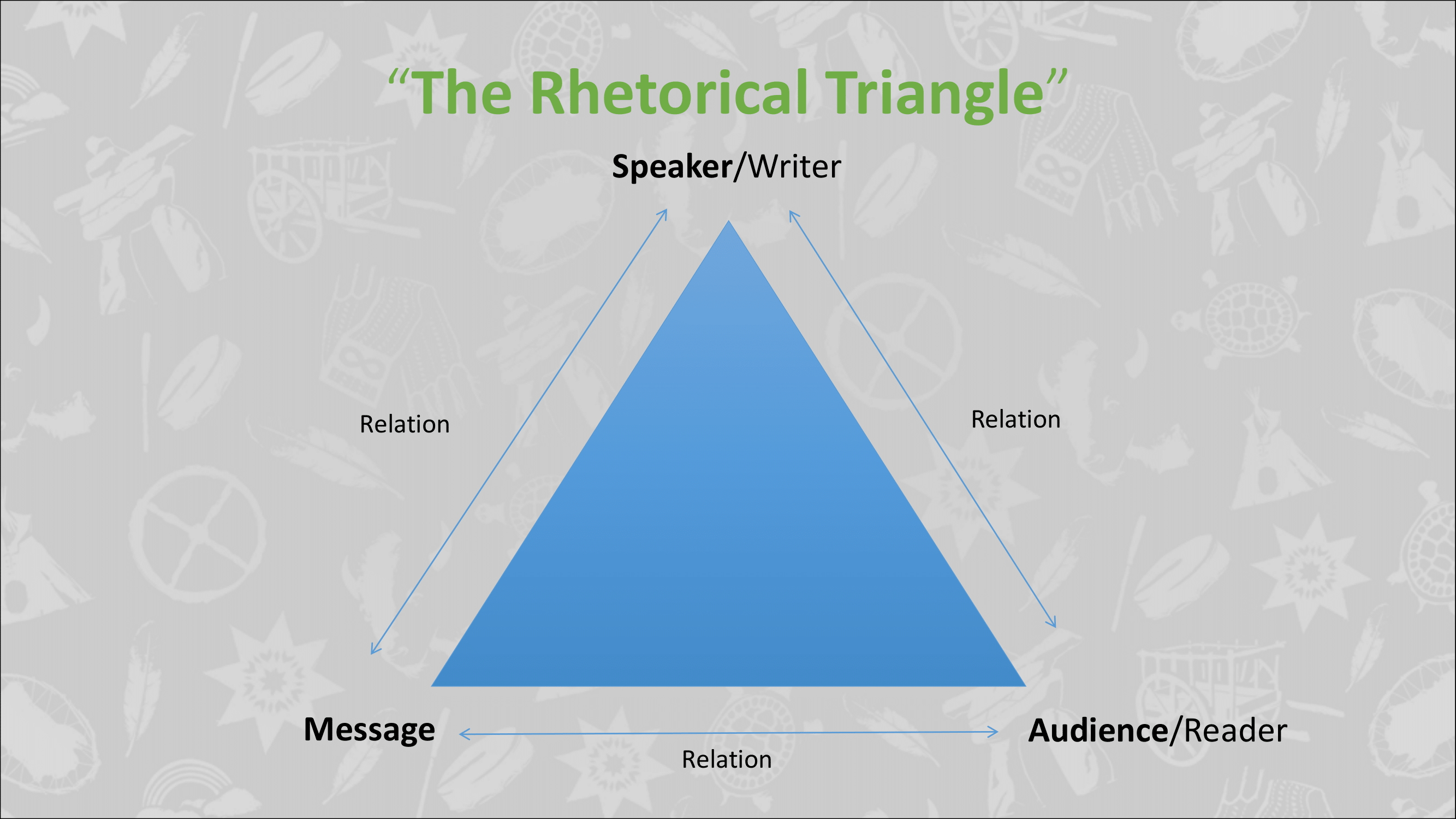The Rhetorical Triangle
Learning Objectives
By the end of this section, you should be able to:
- Differentiate between the Shannon-Weaver model of communication and the rhetorical triangle model of communication.
- Explain why Aristotle’s rhetorical triangle model is the preferred communication model for this course.
When we think about communication, we often imagine it as a simple, one-way process: someone sends a message, and someone else receives it. That’s the basic idea behind the Shannon-Weaver model, which emphasizes technical accuracy and transmission. While applicable in some contexts (such as troubleshooting a poor phone signal), it doesn’t fully capture the richness of genuine human interaction. This chapter introduces you to Aristotle’s rhetorical triangle, which focuses on the speaker, the message, and the audience. This model is better suited for organizational communication because it considers persuasion, relationships, and context. You’ll learn why this approach is the foundation for the rest of this course, and how it can help you communicate more thoughtfully and effectively.
The Shannon-Weaver Model of Communication
Communication textbooks often adopt the Shannon-Weaver Transmission Model (1948) to represent the linear communication process, as shown in the image below.

In this linear model, a sender encodes information and, through a transmitter, sends it to a receiver, who subsequently decodes the message. According to this model then, information seems to move in a simplified, linear manner, even though the process can be complicated by noise, which is information that is added unintentionally to a message during transmission, and feedback, which is information that the receiver transmits back to the sender.
The Shannon-Weaver model does have limits, though. While this communication model provided a fruitful basis for information theory—a body of theory investigating the processes by which information is encoded and transmitted in a digital context—it is less valuable when considering human communication. In this regard, the model fails to represent the dynamic nature of interpersonal communication due to the complexity of people. In other words, the Shannon-Weaver model simplistically depicts an act of communication as though information were somehow shared through a simple, linear action:
Unfortunately, perhaps, this is not how human communication works.
A “Simple” Communication Example
Consider, for instance, the simplest example of human communication: when one person greets another person. Let’s say Person A, whom we’ll refer to as “the speaker,” has a prior relationship with Person B, whom we’ll refer to as “the audience.” In this case, the nature of that relationship will likely influence the greeting the speaker chooses to share. Now, what about the speaker’s relationship to their message? What if they are uncomfortable with small talk and feel compelled to greet the audience, even though the speaker fears that the greeting will invite small talk?
However, the speaker’s relationship to the message will influence how they convey it, regardless of how they feel about the message. If they are anxious to greet the audience, they may be curt in their greeting or create ambiguity by looking away quickly. Now, let’s turn to the audience: how will they interpret such a message? Inevitably, the audience’s understanding will depend, in part, on the nature of their relationship with the speaker and their prior experience with the greeting the speaker offers. That is just one example that illustrates the complexity of analyzing communication. As we will see in this course, communication can be much more intricate.
The Rhetorical Triangle
To account for the complexity of communication, examine the communication model known as the rhetorical triangle. Through this model, we can see that each of the elements of communication—the speaker, audience, and message—is related to the others, and we can understand that communication is a complex, dynamic system. The diagram below shows this.
Now, let’s apply this model to our “simple” communication example from earlier in the chapter:

As the image above shows, a great deal is happening in this single interaction, and all of it co-occurs. The key to success in communication is to recognize it as a dynamic process in which the relationship of the speaker, message, and audience always impacts each other.
Key Takeaways
- The Shannon-Weaver model states that communication is a linear process in which the sender and receiver decode a message.
- While helpful for understanding communication at a basic level, the Shannon-Weaver model does not account for all its complexities.
- In this course, we utilize Aristotle’s rhetorical triangle model because it emphasizes the interrelatedness of the elements of communication—speaker, audience, and message. This model shows that communication is much more dynamic.
References
Communication Theory. (n.d.) [Diagram of Shannon-Weaver’s Model of Communication]. https://www.communicationtheory.org/shannon-and-weaver-model-of-communication/
Attribution
Effective Professional Communication: A Rhetorical Approach Copyright © 2021 by Rebekah Bennetch; Corey Owen; and Zachary Keesey is licensed under a Creative Commons Attribution-NonCommercial-ShareAlike 4.0 International License, except where otherwise noted.
focuses on the speaker, the message, and the audience
It's a linear model of communication that describes communication as a process involving five key elements: an information source, a transmitter, a channel, a receiver, and a destination.
a person who sends a message
a person who receives a message from a sender
information that is added unintentionally to a message during a transmission
information that a receiver sends back to the sender


